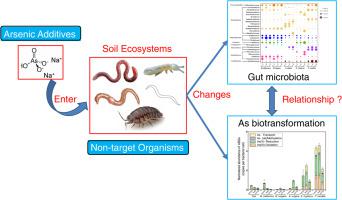Journal of Hazardous Materials ( IF 13.6 ) Pub Date : 2021-05-05 , DOI: 10.1016/j.jhazmat.2021.126018 Hong-Tao Wang 1 , Zong-Zheng Liang 2 , Jing Ding 3 , Xi-Mei Xue 4 , Gang Li 4 , Sheng-Lei Fu 1 , Dong Zhu 5

|
The biotransformation of arsenic mediated by microorganisms plays an important role in the arsenic biogeochemical cycle. However, the fate and biotransformation of arsenic in different soil fauna gut microbiota are largely unknown. Herein the effects of arsenic contamination on five types of soil fauna were compared by examining variations in arsenic bioaccumulation, gut microbiota, and arsenic biotransformation genes (ABGs). Significant difference was observed in the arsenic bioaccumulation across several fauna body tissues, and Metaphire californica had the highest arsenic bioaccumulation, with a value of 107 ± 1.41 mg kg−1. Arsenic exposure significantly altered overall patterns of ABGs; however, dominant genes involved in arsenic redox and other genes involved in arsenic methylation and demethylation were not significantly changed across animals. Except for M. californica, the abundance of ABGs in other animal guts firstly increased and then decreased with increasing arsenic concentrations. In addition, exposure of soil fauna to arsenic led to shifts in the unique gut-associated bacterial community, but the magnitude of these changes varied significantly across ecological groups of soil fauna. A good correlation between the gut bacterial communities and ABG profiles was observed, suggesting that gut microbiota plays important roles in the biotransformation of arsenic. Overall, these results provide a universal profiling of a microbial community capable of arsenic biotransformation in different fauna guts. Considering the global distribution of soil fauna in the terrestrial ecosystem, this finding broadens our understanding of the hidden role of soil fauna in the arsenic bioaccumulation and biogeochemical cycle.
中文翻译:

土壤动物体内砷的生物积累改变了其肠道微生物组和微生物砷的生物转化能力
微生物介导的砷的生物转化在砷的生物地球化学循环中起着重要的作用。然而,砷在不同土壤动物肠道菌群中的命运和生物转化在很大程度上是未知的。在本文中,通过检查砷生物积累,肠道菌群和砷生物转化基因(ABG)的变化,比较了砷污染对五种土壤动物的影响。在几种动物的身体组织中,砷的生物积累量存在显着差异,而加州斜纹夜蛾的砷生物积累量最高,值为107±1.41 mg kg -1。砷暴露显着改变了ABG的总体模式。然而,在动物中,涉及砷氧化还原的显性基因和涉及砷甲基化和脱甲基的其他基因没有显着变化。除加州分枝杆菌外,其他动物肠道中ABG的含量先随砷浓度的增加而增加,然后减少。此外,土壤动物暴露于砷导致独特的肠道相关细菌群落发生变化,但这些变化的幅度在土壤动物生态学各组之间差异很大。观察到肠道细菌群落与ABG谱之间的良好相关性,表明肠道微生物群在砷的生物转化中起重要作用。总体而言,这些结果提供了一种能够在不同动物肠道中进行砷生物转化的微生物群落的普遍概况。考虑到陆地动物在陆地生态系统中的全球分布,这一发现拓宽了我们对土壤动物在砷生物积累和生物地球化学循环中的隐藏作用的理解。


























 京公网安备 11010802027423号
京公网安备 11010802027423号